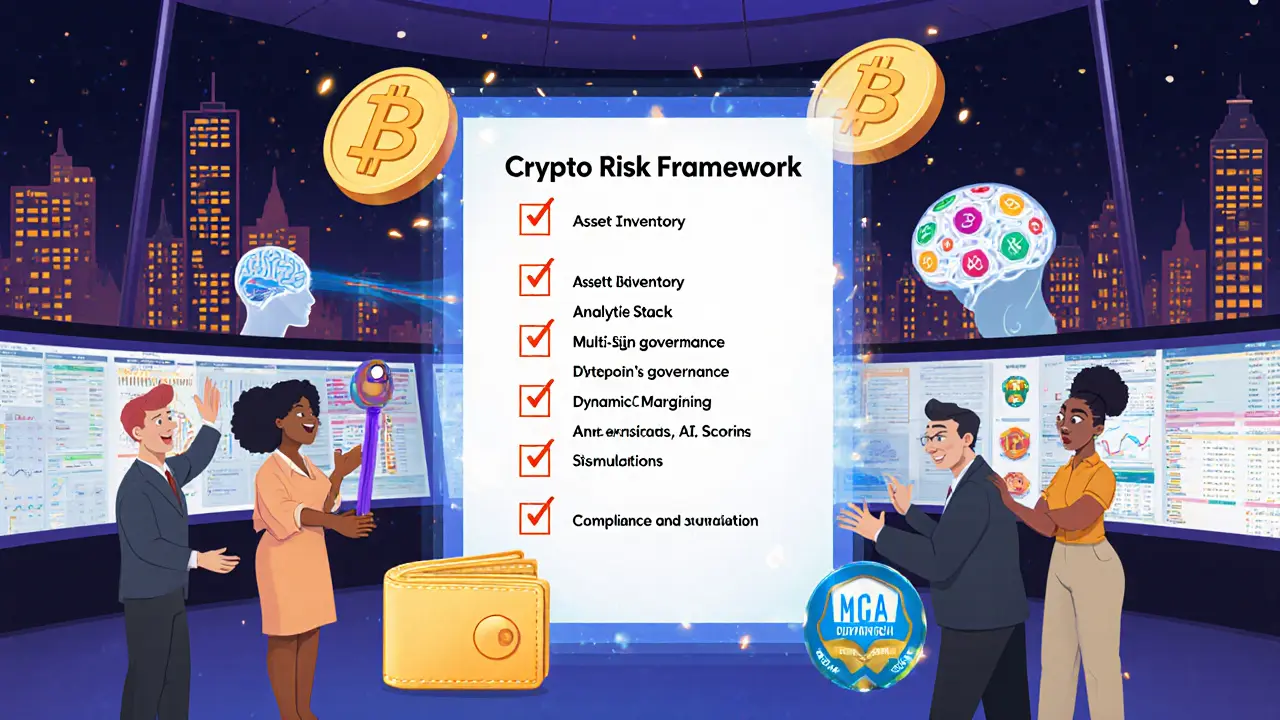Crypto Volatility Risk Calculator
Calculate Your Risk Exposure
Risk Assessment
Potential Loss Estimate
$0
Recommended Strategy
Crypto markets swing like a roller coaster - one minute you’re riding a 30% surge, the next you’re watching a 20% plunge in minutes. That kind of volatility can shred portfolios fast, but the right risk framework can turn chaos into control. Below you’ll learn how to spot threats, arm yourself with the best tools, and stay on the right side of the latest regulations.
Key Takeaways
- Crypto volatility averages 60‑80% annually, demanding dedicated risk controls.
- Four risk buckets - operational, financial, compliance, reputational - cover every angle.
- Institutional players rely on multi‑signature wallets, dynamic margining, and AI‑driven monitoring; retail traders benefit from stop‑losses and volatility alerts.
- MiCA, FATF’s Travel Rule, and the SEC’s pending framework shape compliance from 2024‑2025.
- A practical 6‑step checklist gets a full risk framework up and running in 6‑9 months.
Why Crypto Volatility Is a Different Beast
Volatile crypto markets are the new norm, with Bitcoin’s 90‑day volatility peaking at 67.3% in Q1 2024 (CoinMetrics). Prices can move 20‑30% in a single trading session - a speed traditional assets simply don’t match. The 24/7 nature means risk never sleeps; a bad tweet or a smart‑contract exploit can trigger a cascade while you’re offline.
Because the swings are that big, the classic “buy and hold” playbook needs reinforcement. Think of volatility as a double‑edged sword: it fuels high returns but also magnifies losses if you’re unprepared.
Four Pillars of Crypto Risk
Effective Crypto risk management slices threats into four clear categories. Treat each pillar as a checklist item, not an after‑thought.
- Operational risk - wallet security, private‑key handling, and transaction‑validation errors. Chainalysis reports 78% of institutional breaches in 2023 stemmed from weak key management.
- Financial risk - valuation uncertainty, liquidity crunches, and pure price volatility. High‑frequency swings make mark‑to‑market a daily chore.
- Compliance risk - AML/CFT duties, tax reporting, and cross‑border transaction rules. The FATF Travel Rule, effective Jan 2025, forces data sharing for transfers over $1,000 in 38 jurisdictions.
- Reputational risk - public perception after a breach or association with illicit activity. Elliptic’s 2024 survey shows 63% of institutions suffered brand damage from questionable transactions.
Building a Robust Risk Management Framework
The four‑step loop from Dr. David Carlisle’s 2025 guide works perfectly for crypto:
- Identify - map every asset, wallet, and counterpart.
- Assess - score each exposure using volatility, liquidity, and regulatory weight.
- Monitor - real‑time analytics, on‑chain alerts, and AI‑driven anomaly detection.
- Treat - apply controls like multi‑signatures, dynamic margining, and hedging.
Repeat the loop continuously; crypto never pauses.
Toolbox: Tech That Turns Data Into Defense
Here are the must‑have components for a modern crypto risk stack.
- Multi‑signature wallet - requires 2‑of‑3 signatures for $50k+ moves, 3‑of‑5 for larger transfers. Reduces single‑point‑of‑failure fraud by 73% (BPM 2024).
- Blockchain analytics platforms - Chainalysis Reactor, Elliptic Investigator, and Fireblocks. They monitor 15+ chains, flag 98.7% of suspicious transactions in under 300 ms.
- Know Your Transaction (KYT) engines - automatically screen every transaction against sanctions, PEPs, and illicit‑activity lists.
- Dynamic margining - adjusts collateral in real time based on volatility metrics, cutting liquidation risk by 42% during the March 2023 crash (Fidelity Digital Assets).
- AI‑driven risk scoring - models that learn from on‑chain patterns, reducing false positives by 28% (Chainalysis AI 2024 report).
Institutional vs. Retail: A Side‑by‑Side Look
| Feature | Institutional | Retail |
|---|---|---|
| Wallet security | Multi‑sig (2‑of‑3) + hardware HSM | Single‑sig mobile wallets |
| Margining | Dynamic, volatility‑adjusted collateral | Fixed margin levels |
| Transaction monitoring | AI‑driven KYT, 1,000 tps processing | Basic AML screen, slower batch checks |
| Hedging tools | OTC swaps, futures, options | Exchange‑offered stop‑loss only |
| Compliance reporting | Automated MiCA & FATF filings | Manual tax reports |
Retail traders often rely on simple stop‑loss orders, but those can be “stop‑hunted” in high‑volatility spikes - 28% of traders reported losses during the May 2021 Bitcoin crash (CryptoCompare). Institutions, with layered controls, slash that exposure dramatically.
Volatility‑Specific Strategies
Here are proven tactics to tame the beast:
- Tiered stop‑losses - set tighter stops for high‑beta altcoins, looser for blue‑chip assets.
- Real‑time rebalancing - use dynamic margining to shift collateral as volatility index (VIX‑Crypto) spikes.
- Stablecoin buffers - allocate 5‑10% of portfolio to USDC or USDT to cushion drawdowns. Remember their 0.8‑1.2% annual volatility versus 60‑80% for Bitcoin.
- DeFi insurance - purchase coverage from Nexus Mutual for smart‑contract failures, protecting up to $1.2 billion in assets (Q3 2024 data).
- Options & futures hedges - lock in price floors during expected market turbulence.
Regulatory Landscape: 2024‑2025 Must‑Know Rules
Compliance is no longer optional. Three pillars dominate the scene:
- MiCA (EU) - requires crypto firms to maintain “appropriate risk management systems” by Dec 2024. Non‑EU firms serving EU customers must mirror those controls.
- FATF Travel Rule - Jan 2025 rollout forces all VASPs to transmit originator and beneficiary data for transfers > $1,000. Failure can mean blacklisting in 38 jurisdictions.
- SEC Crypto Asset Risk Framework - proposed Oct 2024, outlines 15 mandatory controls for registered entities, including stress‑testing and liquidity buffers.
Meeting these standards means integrating KYT, continuous audit trails, and real‑time solvency dashboards for stablecoin issuers (US Treasury Oct 2024 policy).
Implementation Checklist - Get Your Framework Live in 6‑9 Months
- Scope assets & wallets - list every on‑chain address, custodial service, and DeFi protocol exposure.
- Choose analytics stack - adopt Chainalysis for AML, Elliptic for transaction risk, and Fireblocks for custody documentation.
- Set up multi‑sig governance - define 2‑of‑3 and 3‑of‑5 thresholds, assign signers, and test failure scenarios.
- Configure dynamic margining - integrate volatility feeds (e.g., CryptoVIX) into collateral calculations.
- Deploy AI risk scoring - train models on historic on‑chain fraud patterns, calibrate false‑positive tolerance.
- Automate compliance reporting - map data fields to MiCA, FATF, and SEC templates; schedule daily uploads.
- Run tabletop simulations - model black‑swan events like a 30% intraday drop, assess liquidity & margin needs.
- Document everything - produce a 300‑page risk manual (Fireblocks style) covering policies, procedures, and incident response.
Expect an upfront cost of $450k‑$1.2 M for midsize firms (BPM 2024). The payoff is lower loss frequency, regulatory peace of mind, and the ability to attract institutional capital.
Common Pitfalls & Pro Tips
- Pitfall: Relying on a single security layer. Tip: Combine hardware HSMs, multi‑sig, and continuous monitoring.
- Pitfall: Ignoring off‑chain exposures (e.g., custodial balances). Tip: Include custodial statements in the asset inventory.
- Pitfall: Treating volatility as a cost only. Tip: Use it as an alpha source with hedges and dynamic allocation.
- Pitfall: Under‑estimating talent needs. Tip: Hire certified CFE or CBP analysts; they command a 25‑30% premium but cut breach risk dramatically.
Take Action Now
Start simple: pick one wallet, enable multi‑sig, and plug a blockchain analytics feed. As you see data, expand to dynamic margining and AI scoring. Remember, the market won’t wait - every hour without a framework is an extra exposure.

What’s the difference between operational and financial crypto risk?
Operational risk covers technical failures - wallet hacks, key loss, or transaction errors. Financial risk deals with market‑driven factors like price swings, liquidity shortages, and valuation uncertainties.
How do I set up a multi‑signature wallet for a small team?
Choose a custodial solution like Fireblocks, create a 2‑of‑3 policy, assign three trusted signers (e.g., CFO, CTO, compliance lead), and run a test transaction to verify the workflow.
Is dynamic margining worth the complexity for a crypto‑focused hedge fund?
Yes. By adjusting collateral in line with real‑time volatility, funds cut liquidation risk by roughly 40% during spikes, according to Fidelity Digital Assets’ 2023 data.
What compliance steps are required under MiCA?
MiCA demands a documented risk management system, regular stress‑testing, AML/KYC procedures, and transparent reporting to national supervisors. Failure to comply can lead to fines up to €10 million.
Can I rely solely on stop‑loss orders to protect my retail portfolio?
Stop‑losses help but aren’t foolproof. During extreme spikes, exchanges may experience slippage or ‘stop hunting.’ Pair them with volatility alerts and a stablecoin buffer for better protection.

Karla Alcantara
October 24, 2025 AT 08:31Great rundown! I love how you break down the four risk pillars and tie them to real‑world tools. For anyone just dipping their toes into crypto, starting with a solid multi‑sig wallet and a simple volatility alert can make a huge difference. Keep the optimism coming – the market’s wild ride is survivable with the right guardrails.
Ralph Nicolay
November 10, 2025 AT 16:11While the article provides a comprehensive overview, it would benefit from a more explicit delineation between operational and financial risk in the context of regulatory compliance. Specifically, operational exposures such as key‑management failures should be mapped to MiCA’s mandated governance controls, whereas financial volatility must be addressed through stress‑testing procedures as outlined in the SEC framework. Moreover, integrating quantitative risk metrics would enhance the practical applicability for institutional adopters.
sundar M
November 28, 2025 AT 00:51Wow, this guide really hits the nail on the head! I can picture the crypto battlefield where every swing is a dragon breathing fire, and our shields – multi‑sig and AI analytics – stand tall. The dynamic margining bit feels like a secret weapon, shifting in real‑time to tame those beastly spikes. And the way you weave compliance into the strategy? Pure gold for anyone wanting to survive the storm.
Nick Carey
December 15, 2025 AT 09:31Looks solid, but honestly, most of us just set a stop‑loss and hope for the best. All that fancy AI stuff feels like overkill for a weekend trader.